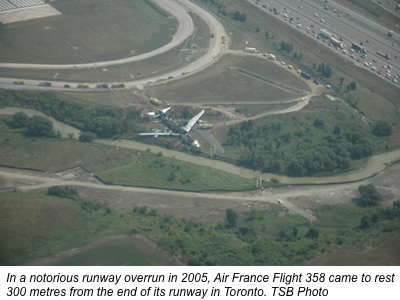Estimated reading time 6 minutes, 6 seconds.
Millions of landings occur each year at Canadian airports-the vast majority of them without incident, with passengers and cargo arriving safely. But roughly once a month, at Canadian airports both large and small, an aircraft overruns the runway. Sometimes, the results are tragic.
Everyone remembers the grim spectre of an Airbus A340 engulfed in flames after landing in a thunderstorm at Toronto’s Pearson International Airport in August 2005. That accident left two passengers and nine crew members with serious injuries. But recent years have also seen overruns at other Canadian cities, including one in Ottawa, Ont.; one in Moncton, N.B.; and two in St. John’s, N.L. The numbers are even more surprising once all operator types are included. In fact, 39 times in the last three years a commercial, corporate, or private aircraft ran off the side or end of a Canadian runway-putting passengers, crew, and cargo at risk.
That’s why the TSB put the issue of overruns on its inaugural safety Watchlist back in 2010, and why the agency kept it on there during a 2012 update. That list, which identifies the greatest risks to Canada’s transportation system, is a blueprint for change, outlining what actions have been taken to date, and what still needs to be done.
Unfortunately, overruns haven’t been easy to eliminate because the issue is complex. To date, TSB investigations have identified many factors, including the stability of the approach; wind direction and speed; the touchdown point and speed of the aircraft; the use of reverse thrust; the friction provided by the runway; weather; and surface conditions such as rain, ice, and snow. We also routinely examine crew training and decision-making, as well as company procedures, brake designs, and aircraft certification.
Nonetheless, there are a few things that we know can help-starting with making sure that aircraft have the room they need, when they need it.
One way to do this is to create a buffer strip at the end of the runway, followed by a Runway End Safety Area (RESA). How big do these need to be? Well, according to a 1987 study conducted by the U.S. Federal Aviation Administration (FAA), 90 per cent of aircraft that overrun runways stop within 300 metres of a runway’s end. This figure was re-confirmed in a 2009 study by the Australian Transport Safety Bureau. Not surprisingly, these countries are world leaders for RESAs, and for an additional defence known as arrestor beds-which use a layer of lightweight, crushable concrete to slow a plane’s wheels by breaking apart under heavy weight.
In Canada, our regulatory standards for runways lag behind international standards and best practices in other countries. That’s disappointing. Transport Canada (TC) currently requires only a 60-metre buffer strip at the end of runways 800 metres or longer, though it recommends an additional 90-metre RESA for runways 1200 metres or longer. The 60 metres required plus the 90-metre recommendation would only match the minimum 150-metre standard set out by the International Civil Aviation Organization. But ICAO also recommends an additional 240-metre RESA at the end of a 60-metre strip-again, bringing us back to the magic number of 300.
While the TSB understands that solutions to overruns can be expensive, doing nothing may ultimately cost even more. For example, a Flight Safety Foundation study found that, between 2005 and 2007, runway excursions cost the aviation industry $506 million per year in damages, in delays due to downtime, and in litigation.
The good news is that today, TC is proposing that Canada’s longer runways match ICAO’s 150-metre minimum standard for RESAs. And while the debate remains ongoing, some airport operators are taking the initiative and going further. Ottawa’s Macdonald-Cartier International Airport, for example, installed a 300-metre RESA at both ends of Runway 07 in 2012, and it has committed to installing another at each end of Runway 14/32 this year. In Toronto, meanwhile, while some runway ends at Pearson International already had a 150-metre RESA, additional work was done in 2012 to bring some others to that length.
More, however, can still be done, particularly during bad weather. Reducing the number of runway overruns in Canada will take numerous lines of defence and will involve crews, companies and regulators working together. Airport operators, meanwhile, must determine which of their runways pose the greatest risk and then develop appropriate mitigation measures-whether that’s improving surface friction, increasing RESA length, or installing an arrestor bed.
The Transportation Safety Board, meanwhile, continues to learn from its ongoing investigations, pushing for change-and safer landings-for all Canadians.
The TSB is an independent agency that investigates marine, pipeline, railway and aviation transportation occurrences. Its sole aim is the advancement of transportation safety. It is not the function of the Board to assign fault or determine civil or criminal liability. For more information, visit www.tsb.gc.ca.

